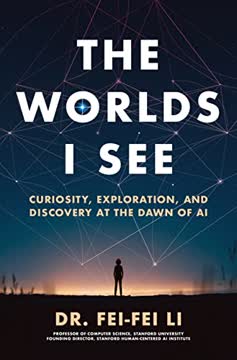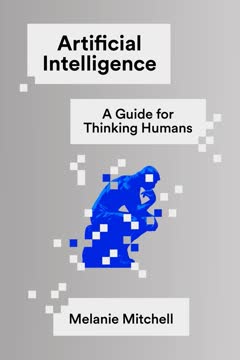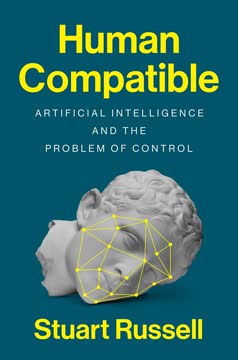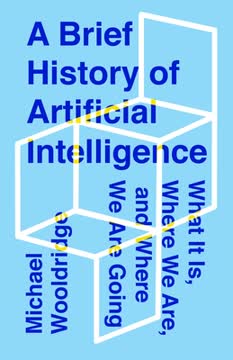Key Takeaways
1. AI's evolution: From symbolic reasoning to data-driven learning
AI has been the subject of continuous research for more than half a century, but during this time, AI researchers have repeatedly claimed to have made breakthroughs that bring the dream of intelligent machines within reach, only to have their claims exposed as hopelessly overoptimistic in every case.
Early AI approaches. The field of artificial intelligence has undergone significant transformations since its inception in the 1950s. Initially, AI research focused on symbolic reasoning and knowledge representation, aiming to create systems that could mimic human problem-solving abilities. This approach, known as symbolic AI or GOFAI (Good Old-Fashioned AI), dominated the field for several decades.
Paradigm shift. However, the limitations of symbolic AI became apparent, leading to a paradigm shift towards data-driven approaches. Machine learning, particularly deep learning, emerged as the dominant paradigm in the 21st century. This shift was driven by the availability of large datasets, increased computational power, and breakthroughs in neural network architectures. The success of deep learning in tasks such as image recognition, natural language processing, and game playing has reignited interest in AI and led to significant advancements in the field.
2. The limitations of current AI systems and the challenges of general AI
All the impressive capabilities we have developed—image recognition, language translation, driverless cars—don't add up to general intelligence.
Narrow AI vs. General AI. Despite remarkable achievements in specific domains, current AI systems are examples of narrow or weak AI, designed to perform specific tasks without genuine understanding or general intelligence. These systems lack the ability to transfer knowledge across domains or exhibit common-sense reasoning, which are crucial aspects of human intelligence.
Challenges of AGI. The development of Artificial General Intelligence (AGI) – systems with human-level intelligence across a wide range of cognitive tasks – remains a significant challenge. Key obstacles include:
- Lack of common-sense reasoning
- Inability to learn and adapt quickly to new situations
- Absence of true understanding and consciousness
- Difficulties in integrating different cognitive capabilities
The path to AGI is unclear, and many researchers believe it may require fundamentally new approaches and breakthroughs in our understanding of intelligence and cognition.
3. Machine learning and deep neural networks: The driving force of modern AI
Deep learning opened the floodgates for applications of AI. In the second decade of the twenty-first century, AI has attracted more interest than any new technology since the World Wide Web in the 1990s.
Deep learning revolution. Deep learning, a subset of machine learning based on artificial neural networks, has been the primary driver of recent AI advancements. This approach allows systems to automatically learn features and representations from large amounts of data, leading to breakthroughs in various domains.
Key applications and achievements of deep learning include:
- Image and speech recognition
- Natural language processing and translation
- Game playing (e.g., AlphaGo, AlphaZero)
- Autonomous vehicles
- Medical diagnosis and drug discovery
Limitations and challenges. Despite its success, deep learning has limitations:
- Requirement for large amounts of labeled data
- Lack of interpretability ("black box" problem)
- Vulnerability to adversarial attacks
- Difficulty in incorporating prior knowledge or logical reasoning
Addressing these challenges is crucial for the continued advancement and widespread adoption of AI technologies.
4. AI's impact on employment and the changing nature of work
I firmly believe that AI and the associated technologies of advanced automation and robotics will make many people redundant in the near future.
Job displacement. AI and automation are likely to significantly impact the job market, potentially leading to the displacement of many workers in various industries. Jobs that involve routine, predictable tasks are particularly vulnerable to automation.
Evolving job landscape. While AI may eliminate some jobs, it is also expected to create new roles and transform existing ones. The job market is likely to evolve in the following ways:
- Increased demand for AI specialists, data scientists, and robotics engineers
- Greater emphasis on uniquely human skills such as creativity, emotional intelligence, and complex problem-solving
- Shift towards jobs that involve human-AI collaboration
- Need for continuous learning and adaptation to new technologies
Societal implications. The widespread adoption of AI in the workplace raises important questions about income inequality, education and training, and the need for potential policy interventions such as universal basic income or job retraining programs.
5. Ethical considerations and potential risks of AI development
While on the one hand I found coverage of the Facebook incident rather comical, it also left me deeply frustrated. The problem is, reporting of this kind panders to the Terminator narrative of AI: that we are creating something we won't be able to control, which could pose an existential risk to humanity.
Realistic concerns. While fears of superintelligent AI taking over the world are largely unfounded, there are legitimate ethical concerns surrounding AI development and deployment:
- Bias and fairness in AI decision-making systems
- Privacy and data protection
- Transparency and explainability of AI systems
- Accountability for AI-driven decisions
- Potential misuse of AI technologies (e.g., autonomous weapons, deepfakes)
Responsible AI development. Addressing these concerns requires a multi-faceted approach:
- Developing ethical guidelines and frameworks for AI development
- Promoting diversity and inclusivity in AI research and development teams
- Implementing robust testing and validation procedures for AI systems
- Encouraging interdisciplinary collaboration between AI researchers, ethicists, and policymakers
- Educating the public about AI capabilities and limitations
6. The role of AI in healthcare, transportation, and decision-making
AI-powered health care management is made possible by the advent of wearable technology—smartwatches like the Apple Watch, and activity/fitness trackers such as Fitbit.
Healthcare applications. AI is poised to revolutionize healthcare through:
- Early disease detection and diagnosis
- Personalized treatment recommendations
- Drug discovery and development
- Healthcare management and resource allocation
- Wearable devices for continuous health monitoring
Autonomous vehicles. AI is driving the development of self-driving cars, which have the potential to:
- Reduce traffic accidents and fatalities
- Improve transportation efficiency
- Enhance mobility for elderly and disabled individuals
- Reshape urban planning and infrastructure
AI-assisted decision-making. AI systems are increasingly being used to support or automate decision-making processes in various domains, including:
- Financial services (e.g., credit scoring, fraud detection)
- Criminal justice (e.g., risk assessment)
- Resource allocation in businesses and governments
- Scientific research and discovery
While these applications offer significant benefits, they also raise important questions about accountability, transparency, and the role of human judgment in AI-assisted decision-making.
7. The quest for conscious machines and the nature of intelligence
The phenomena of mind and consciousness in people—how they evolved, how they work, and even the functional role that they play in our behavior—are as utterly mysterious to us now as the forces that powered the sun were to scientists then.
Consciousness and AI. The development of conscious machines remains a distant and controversial goal in AI research. Key challenges include:
- Lack of scientific understanding of consciousness
- Difficulty in defining and measuring consciousness
- Philosophical debates about the nature of consciousness and its relationship to intelligence
Alternative approaches. Rather than pursuing human-like consciousness, some researchers focus on developing AI systems with:
- Advanced social reasoning capabilities
- Theory of mind (ability to understand and reason about others' mental states)
- Improved adaptability and generalization across tasks
Implications for AI development. The quest for conscious machines raises fundamental questions about:
- The nature of intelligence and consciousness
- The relationship between biological and artificial intelligence
- Ethical considerations in creating potentially sentient artificial beings
While true machine consciousness remains a distant goal, research in this area continues to provide valuable insights into both artificial and human intelligence.
Last updated:
FAQ
What's A Brief History of Artificial Intelligence about?
- Comprehensive Overview: The book provides a detailed history of AI, from its early concepts to modern advancements, highlighting key milestones and influential figures.
- Practical Applications: It emphasizes real-world applications of AI, such as in healthcare and automated translation, rather than speculative or dystopian scenarios.
- Historical Context: The author discusses the cyclical nature of AI's progress, marked by periods of optimism and setbacks, and the challenges faced by researchers.
Why should I read A Brief History of Artificial Intelligence?
- Informed Perspective: The book offers a well-rounded understanding of AI, helping to separate fact from fiction and clarify common misconceptions.
- Engaging Narrative: Michael Wooldridge presents complex concepts in an accessible manner, making the book suitable for both newcomers and those with some background in AI.
- Broader Implications: It addresses the ethical and societal impacts of AI, which are crucial for understanding technology's role in our lives.
What are the key takeaways of A Brief History of Artificial Intelligence?
- Interdisciplinary Nature: AI is a multifaceted field that draws from philosophy, psychology, and computer science, requiring an appreciation of its complexity.
- Challenges and Limitations: The book discusses the inherent difficulties in creating AI, such as the complexity of human-like intelligence and current technological limitations.
- Real-World Impact: Successful AI applications in areas like healthcare demonstrate its potential to improve lives, contrasting with sensationalized media narratives.
What are the best quotes from A Brief History of Artificial Intelligence and what do they mean?
- "AI is my life.": Reflects Wooldridge's deep passion for AI, indicating that his insights are rooted in personal experience and commitment.
- "What AI is (and isn’t)": Encapsulates the book's mission to clarify misconceptions, distinguishing between media portrayals and practical realities.
- "Intelligence is embodied.": Highlights the idea that true intelligence requires physical presence and interaction with the world, contrasting with disembodied AI systems.
How does Michael Wooldridge define AI in A Brief History of Artificial Intelligence?
- Task-Oriented Definition: AI is defined as the ability of machines to perform tasks that typically require human intelligence, such as problem-solving and pattern recognition.
- Distinction from Human Intelligence: AI does not equate to human-like thinking or consciousness, a crucial distinction for understanding its capabilities and limitations.
- Interdisciplinary Approach: AI draws from various fields, showcasing its complexity and the collaborative efforts required to advance it.
What is the "grand dream" of AI mentioned in A Brief History of Artificial Intelligence?
- Definition: The "grand dream" refers to creating machines with human-like intelligence, including self-awareness and consciousness, often depicted in science fiction.
- Contentious Nature: There is no consensus among researchers about the feasibility or desirability of this dream, raising philosophical questions about intelligence.
- Practical Focus: Current AI research is more concerned with specific tasks rather than achieving the grand dream, which is often misunderstood by the public.
What role does machine learning play in modern AI, as discussed in A Brief History of Artificial Intelligence?
- Core Technology: Machine learning is central to contemporary AI, enabling systems to learn from data and improve over time, transforming AI research and applications.
- Types of Learning: The book explains different types of machine learning, such as supervised and reinforcement learning, each with its own methodologies and applications.
- Neural Networks and Deep Learning: Discusses the resurgence of neural networks through deep learning, leading to advancements in image recognition and natural language processing.
What are the main challenges in creating AI, according to A Brief History of Artificial Intelligence?
- Complexity of Human Intelligence: Replicating human-like intelligence is difficult due to its complexity and our limited understanding of how it works.
- Computational Limitations: Many AI problems remain computationally intensive and difficult to solve efficiently, such as issues related to combinatorial explosion.
- Ethical and Societal Implications: The book raises concerns about job displacement and privacy issues, necessitating careful consideration as AI evolves.
How does A Brief History of Artificial Intelligence address the public's perception of AI?
- Media Sensationalism: Critiques the media's focus on dystopian scenarios and superintelligent machines, which overshadow practical AI research.
- Informed Discussion: Emphasizes the importance of informed public discourse about AI, advocating for a nuanced understanding of its capabilities and limitations.
- Changing the Narrative: Aims to shift the narrative from fear and speculation to excitement and potential, focusing on real-world applications that benefit society.
What is the significance of Alan Turing in the context of A Brief History of Artificial Intelligence?
- Pioneer of Computing: Alan Turing is recognized as a foundational figure in computer science and AI, laying the groundwork for understanding computation and algorithms.
- Turing Test: The Turing Test is discussed as a measure of machine intelligence, remaining a significant reference in AI capability discussions.
- Philosophical Contributions: Turing's ideas raise important questions about consciousness and intelligence, influencing contemporary AI research.
How does A Brief History of Artificial Intelligence differentiate between narrow AI and general AI?
- Narrow AI Defined: Refers to systems designed for specific tasks, excelling in their areas but lacking the ability to generalize knowledge across domains.
- General AI Aspirations: Aims to replicate human-like intelligence, enabling machines to understand and apply knowledge across various tasks, a significant challenge.
- Current State: Highlights that while narrow AI has progressed, general AI remains elusive, crucial for setting realistic expectations about AI capabilities.
What are the limitations of deep learning as discussed in A Brief History of Artificial Intelligence?
- Lack of Understanding: Deep learning excels at specific tasks but lacks broader contextual knowledge and true understanding.
- Dependence on Data: Effectiveness relies on the quality and quantity of training data, leading to biases and inaccuracies if data is flawed.
- Need for Integration: Deep learning alone is insufficient for general AI; integration with other knowledge representation forms is necessary for future advancements.
Review Summary
"A Brief History of Artificial Intelligence" offers a concise, accessible overview of AI's development, from its early days to current advancements. Readers appreciate Wooldridge's pragmatic approach, avoiding alarmist narratives while addressing potential challenges. The book provides valuable insights for both newcomers and those familiar with AI. Some find it too technical for beginners, while others wish for more depth. Reviewers praise its balanced perspective on AI's history, current state, and future possibilities, though some note that rapid advancements may quickly date certain sections.
Similar Books










Download PDF
Download EPUB
.epub digital book format is ideal for reading ebooks on phones, tablets, and e-readers.




